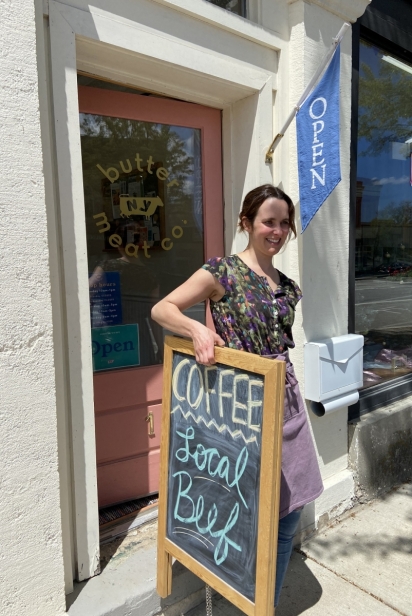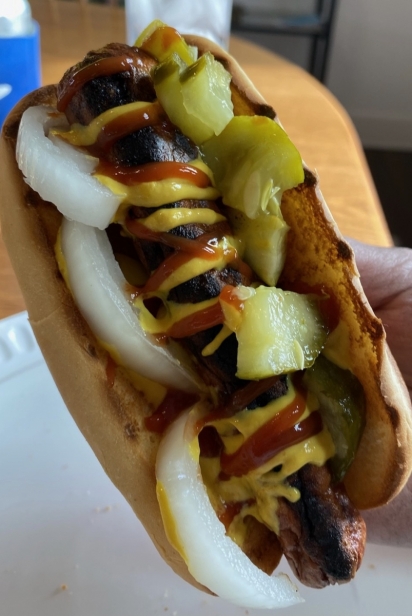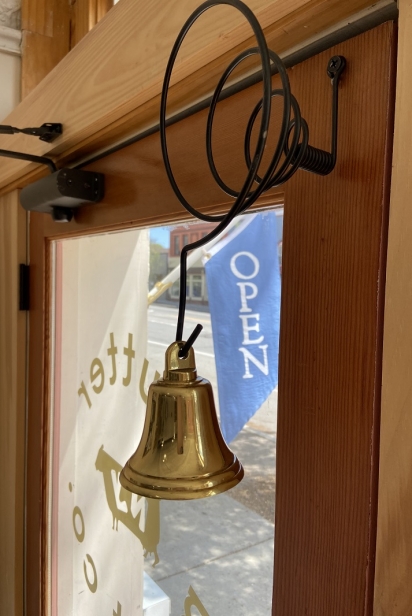Perry's Butter Meat Co: Dual Purposed and Full of Flavor
Gould, who has a degree in agricultural sciences from Cornell, acquired experience in food supply chain management as a Global Food Source Manager for Walmart, with stints in food supply and fulfillment at Sam’s Club and Blue Apron, a meal delivery service.
Her experience with food sourcing for large retailers gave her an idea. Gould knew she had to rethink the reality of food on store shelves going unused. Coupled with a desire to “build a grassroots brand” was a commitment to meet the food-sourcing needs of today’s consumer by improving upon a model that, as she says, includes a lot of wasted food.
With an entrepreneurial spirit in high gear, she found herself back on a farm in Western New York after college, close to where she’d grown up. She applied for an LLC in 2018 with aspirations to start a business focused on what she knew best: agriculture.
“I believed I had returned to Western New York for a reason,” Gould says. “I just had to dig deeper to figure out why.”
Gould grew up in Elba, NY, on a vegetable farm not far from her store and the dairy farm owned by her husband, Steve, and his family. She met Steve Gould, a third-generation dairy farmer, at Cornell. The two married. The Gould family farm, Har-Go Farms, is a 600-acre organic dairy farm in Pavilion, NY, home to 200 dairy cows.
Gould discovered the true value of dual-purpose beef when friends, including chef Yi Wah Roberts, visited the farm.
“Unexpected visitors and an empty refrigerator provided only one option: a freezer full of dairy-breed beef,” Gould recalls. “Roberts had worked in high-end restaurants in Washington DC and at the renowned Citronelle, owned by late chef Michel Richard. I was nervous when I handed him a steak from our freezer.”
As it turns out, Gould’s concerns about how this type of beef would be received were quickly dispelled.
Roberts noticed that when seared, the steak’s fat was smooth instead of sticky. The smell and look of the beef, both raw and cooked, was unlike other beef. The steak’s color was a deep burgundy and its bone marrow the color of egg yolk.
“That visit was a turning point in my quest to start a food business,” Gould explains. “There were a handful of dairy farms selling their own beef across the country. As far back as 2011, a company in California was already catering to high-end chefs. Research led me to believe there was a market here for this type of beef.”
Gould discovered she had to dispel some preconceptions about the quality and taste of dual-purpose beef.
“The perception that beef from dairy cows is bad beef is accepted only by people who haven’t tried it,” Gould explains. “We are raised to believe that Angus is the only premium beef. But in reality, nearly all beef in Europe—particularly Spain and France—and historically in the U.S., came from dairy-breed cows. Today, the beef we eat from most outlets is from younger cows. Cows that have lived five or six years provide much more flavorful beef.”
In an attempt to launch her business, she filled her trunk with beef and hit the road.
“I thought, 'If local and regional chefs could try this beef; if they could experience the flavor profile and unique texture, they’d be sold,’” she recalls.
Chefs were enthusiastic about the beef but, surprisingly, many didn’t order her product. She realized she’d have to work harder to cultivate interest.
Then, riding a resurgence of retail food outlets on Main Street in Perry, Gould found a place to set up shop. The pre–Civil War building where Butter Meat Co. is housed had been vacant for nearly 20 years. A pizzeria, bakery, wine bar and brewing company nearby were attracting customers. All was going swimmingly until COVID-19 hit just one month after she opened.
“I had to rethink many of the plans I had for the store,” she says. “I had envisioned it to be in part a learning center where customers could discover the best cuts and learn how best to prepare the beef I was offering for sale.”
She converted most of her business to online ordering and expanded her in-store product line to include locally sourced dairy products and grocery items. Today, customers are back in the store, and Gould is able to have the conversations she envisioned about the value of organic dual-purpose American beef.
According to Gould, meat producers in the U.S. are beginning to market dual-purpose beef as a delicacy and the product now has an audience.
At Butter Meat Co., the product is especially appealing as the organic integrity is maintained throughout the lifetime of the animals, from the dairy farm to the store. As a certified organic handler, Gould has been trained in how animals are slaughtered and butchered as well as safety and sanitation in the handling of beef. She relies upon two organic processors in Pennsylvania.
Butter Meat Co. customers can select their own cuts of beef in the shop or purchase 10-pound boxes with a curated selection of cuts. Each box comes with an educational meat tasting guide from the Good Meat Project. Similar to tasting wine, cheese or chocolate, the nuances of aroma, texture, mouthfeel and flavor effect the experience of eating meat.
And Gould adds that while the flavor and texture of this beef is second to none, eating dual-purpose beef is also ecologically sound.
“There are environmental reasons why dual-purpose beef is a better option,” she explains. “A farmer incurs a fixed cost when raising a cow. In a lifetime, a dairy cow may produce 60 to 80 thousand gallons of milk, then at the end of its life, 600–800 pounds of beef. A cow raised for its beef alone is grazing just as much but will only provide beef at the end of its life.”
The tradition of dual-purpose beef was replaced by beef cows in the U.S. by farmers who had surplus crops, particularly corn and soybeans. The surplus allowed them to raise cows strictly for their beef.
“Conserving grass or feed for cows was not an issue here because the U.S. was so rich in farmland,” Gould says. “I believe, as we become more ecologically aware, this type of conservation of resources and a push toward dual-purpose beef will appeal to more people for its taste and the benefit to our environment.”
But the quality of this meat will convert people to its texture, color and taste.
“After all,” Gould asks, “if wine and cheese get better with age, then, why not beef?”








